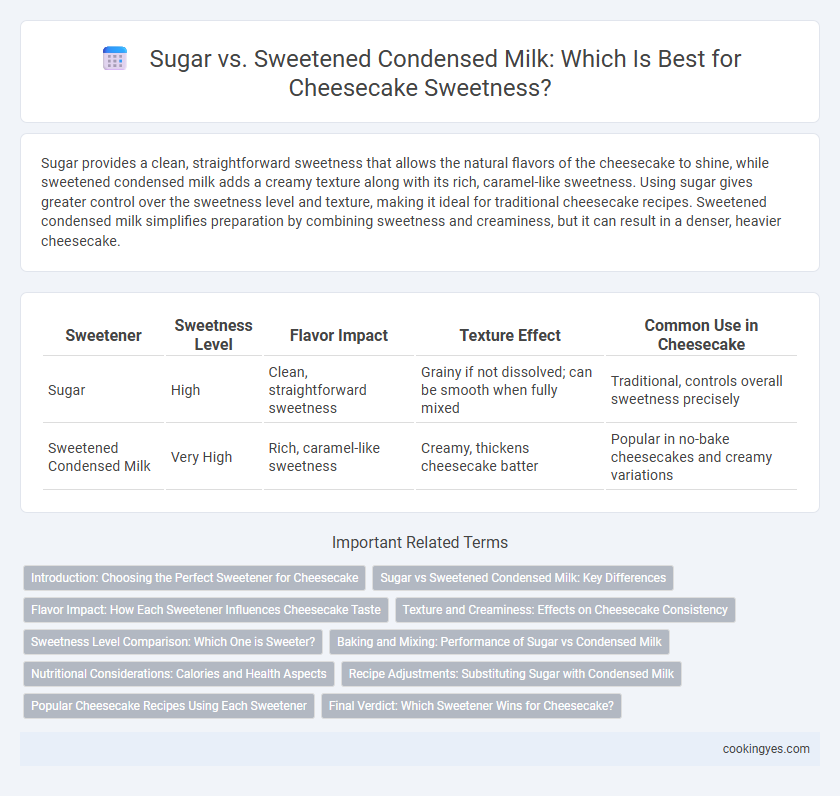Sugar provides a clean, straightforward sweetness that allows the natural flavors of the cheesecake to shine, while sweetened condensed milk adds a creamy texture along with its rich, caramel-like sweetness. Using sugar gives greater control over the sweetness level and texture, making it ideal for traditional cheesecake recipes. Sweetened condensed milk simplifies preparation by combining sweetness and creaminess, but it can result in a denser, heavier cheesecake.
Table of Comparison
| Sweetener | Sweetness Level | Flavor Impact | Texture Effect | Common Use in Cheesecake |
|---|---|---|---|---|
| Sugar | High | Clean, straightforward sweetness | Grainy if not dissolved; can be smooth when fully mixed | Traditional, controls overall sweetness precisely |
| Sweetened Condensed Milk | Very High | Rich, caramel-like sweetness | Creamy, thickens cheesecake batter | Popular in no-bake cheesecakes and creamy variations |
Introduction: Choosing the Perfect Sweetener for Cheesecake
Choosing the perfect sweetener for cheesecake significantly impacts its texture and flavor profile. Granulated sugar provides a clean, straightforward sweetness that balances the rich cream cheese, while sweetened condensed milk adds both sweetness and a creamy, dense texture due to its thick consistency and milk solids. Understanding the distinct effects of these sweeteners allows bakers to tailor their cheesecake to achieve either a light, classic taste or a richer, more indulgent dessert experience.
Sugar vs Sweetened Condensed Milk: Key Differences
Sugar provides precise control over sweetness levels and texture, allowing bakers to adjust according to taste without altering moisture content. Sweetened condensed milk combines sugar and milk, adding both sweetness and creaminess, which can affect the cheesecake's density and richness. Choosing between sugar and sweetened condensed milk impacts the balance of sweetness, texture, and overall mouthfeel in cheesecake recipes.
Flavor Impact: How Each Sweetener Influences Cheesecake Taste
Granulated sugar provides a clean, straightforward sweetness that enhances the creamy texture of cheesecake without altering its natural flavors. Sweetened condensed milk contributes a rich, caramel-like depth and a denser mouthfeel, intensifying the dessert's sweetness and adding a subtle complexity. Choosing between these sweeteners significantly shapes the cheesecake's flavor profile, with sugar offering brightness and sweetened condensed milk delivering a more indulgent, layered taste.
Texture and Creaminess: Effects on Cheesecake Consistency
Sugar enhances cheesecake by dissolving into the batter, preserving a smooth texture and allowing the cream cheese to maintain its dense, creamy consistency. Sweetened condensed milk contributes not only sweetness but also extra moisture and fat, resulting in a richer, silkier texture that yields a more velvety and slightly softer cheesecake. The choice between sugar and sweetened condensed milk directly influences the final mouthfeel, with sugar promoting firmness and powdered smoothness, while condensed milk imparts luscious creaminess and a tender crumb.
Sweetness Level Comparison: Which One is Sweeter?
Sweetened condensed milk is significantly sweeter than granulated sugar due to its high sugar concentration and concentrated milk solids, providing a rich, caramelized sweetness that enhances cheesecake flavor. Granulated sugar delivers a clean, straightforward sweetness, allowing greater control over the final sweetness level in the cheesecake. Choosing sweetened condensed milk results in a denser, creamier texture with a more intense sweetness, while sugar offers versatility in sweetness adjustment and texture balance.
Baking and Mixing: Performance of Sugar vs Condensed Milk
Granulated sugar provides precise control over sweetness and texture in cheesecake recipes, allowing for gradual incorporation during mixing and predictable caramelization in baking. Sweetened condensed milk contributes both sweetness and moisture, enhancing creaminess while reducing baking time due to its viscous consistency and added milk solids. Using sugar results in a firmer structural integrity, whereas sweetened condensed milk yields a denser, smoother crumb with a richer mouthfeel.
Nutritional Considerations: Calories and Health Aspects
Sugar adds sweetness to cheesecake with 16 calories per teaspoon and no additional nutrients, contributing to rapid blood sugar spikes. Sweetened condensed milk contains about 62 calories per tablespoon along with fat and protein, offering a denser calorie source but slightly more nutritional value. Choosing between sugar and sweetened condensed milk affects not only the cheesecake's flavor profile but also its caloric density and glycemic impact, important for mindful consumption.
Recipe Adjustments: Substituting Sugar with Condensed Milk
When substituting sugar with sweetened condensed milk in cheesecake recipes, reduce other liquid ingredients to maintain batter consistency, as condensed milk adds both sweetness and moisture. Sweetened condensed milk provides a richer flavor and creamier texture compared to granulated sugar, often resulting in a denser cheesecake. Adjust baking time slightly to prevent over-browning, since condensed milk caramelizes faster than sugar.
Popular Cheesecake Recipes Using Each Sweetener
Popular cheesecake recipes using sugar typically highlight classic New York-style cheesecakes where granulated sugar provides a clean, balanced sweetness that enhances the creamy texture without overpowering the cream cheese flavor. Sweetened condensed milk is often featured in no-bake cheesecakes and Filipino-style cheesecakes, delivering a richer, denser sweetness with a smooth, velvety consistency that eliminates the need for additional sugar. Both sweeteners impact the final dessert's texture and flavor profile, with sugar offering a more traditional, subtly sweet result and condensed milk contributing a uniquely creamy and caramelized note.
Final Verdict: Which Sweetener Wins for Cheesecake?
Sugar provides precise control over sweetness and texture in cheesecake, allowing for a classic, clean flavor profile with a firm consistency. Sweetened condensed milk adds a rich, creamy sweetness and moisture, resulting in a denser, smoother cheesecake but can be harder to adjust in sweetness levels. The final verdict favors sugar for traditional cheesecakes due to its versatility and balance, while sweetened condensed milk is ideal for no-bake or creamier, more indulgent variations.
Sugar vs sweetened condensed milk for cheesecake sweetness Infographic

 cookingyes.com
cookingyes.com